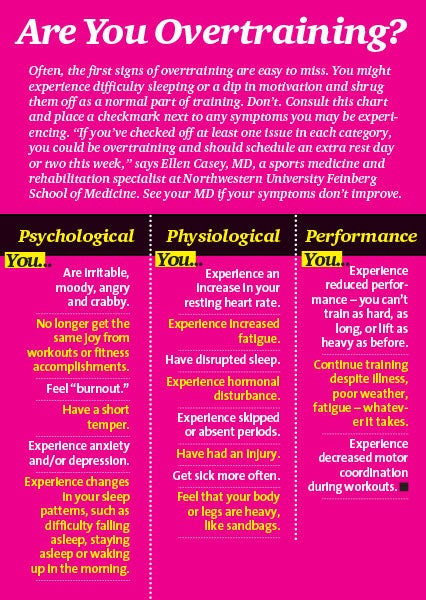Heading out the door? Read this article on the new Outside+ app available now on iOS devices for members! Download the app.

As a fitness-minded woman, Chanel Roehner, 25, of Newport Beach, California, thought she was in touch with her body. With her mind set on competing in Figure competitions, she assumed that “more” really was more when it came to her training: lifting more, spending more days in the gym, and pushing herself more and more every day. “‘Go harder and faster and heavier,’ I would tell myself,” says Chanel. “Work through the pain!”
Soon, she was putting in two to three workouts per day, six to seven days per week. But one year into her routine, Chanel’s obsession with her workouts finally backfired. Several serious injuries, including fractures to both sides of her L-5 vertebrae and a stress fracture to her sacroiliac joint meant she had to stop training entirely for more than two months. Now, Chanel has gradually worked her way back to a program of cardio and weights, but there are still moves she can’t perform due to her injury. “My training routine literally broke my back,” she says.
The cause of Chanel’s injury? Overtraining. “It occurs when you put a great deal of stress on the body without giving it adequate rest to adapt and recover,” says Neal Henderson, CSCS, exercise physiologist and director of sport science at Boulder Community Hospital in Colorado. Not only does this set the stage for injuries such as tendonitis and stress fractures like Chanel’s, it can also cause a host of more subtle symptoms, including fatigue, irritability, sleep problems, depression and hormonal disturbances.
What’s more, a new study reports that prolonged periods of strenuous exercise reduce levels of important immune cells called natural killer cells, raising your risk of contracting upper respiratory tract infections, which can also sideline your training. As if those symptoms weren’t a large enough price to pay, overtraining can stall or reverse your muscle gains and fat loss. “Without enough rest, your body doesn’t get the opportunity to rebuild and repair the muscle fibers you stressed during your workout, so they begin to break down, which is counterproductive to your fitness goals and performance,” says William Kraemer, PhD, professor of kinesiology at the University of Connecticut’s Neag School of Education.
The sneaky thing about overtraining, however, is that it can be difficult to diagnose. “Doctors may miss the signs of overtraining because there’s no test for it,” says Suzanne Hecht, MD, team physician for the University of Minnesota athletics department. “It’s often a diagnosis of exclusion, meaning your doctor has to rule out other conditions, such as an underactive thyroid, depression or anemia, that could cause similar symptoms.” The key is taking steps to avoid overtraining altogether.
When Less Is More
Experts agree that the best way to safeguard your body is making your rest days just as integral to your training program as your workouts. “You don’t actually get stronger, fitter or faster when you’re doing an activity,” Henderson says. “It’s only during rest that your body repairs itself, adapts and rebounds to a higher level.”
Rest can take on several different forms. There’s complete rest, where you only perform activities that are essential to your daily life, and then there’s active rest, where you may do some kind of low-impact activity, such as walking, swimming, bike riding, gentle yoga or Pilates. “Several active recovery days per week can help send blood flow to your muscle tissues, flush out inflammatory molecules, and replace glycogen stores, which reduces soreness and aids in recovery,” Henderson says. “But it’s important to take at least one complete rest day per week to give your body the opportunity to fully heal.”
It’s also important to schedule your workouts in such a way that gives your muscles a minimum of 48 hours between training the same body part. “If you’re lifting to failure, which is often necessary for making strength gains, then you need even more time – about 72 hours — between training the same body part,” says Ellen Casey, MD, a sports and rehabilitation specialist at Northwestern University Feinberg School of Medicine. “The extent of muscle breakdown when lifting to failure is often much greater than with other techniques, and therefore requires additional time to repair.”
To make sure you’re giving your body adequate rest, create a weekly or monthly schedule — and stick to it. In the schedule, write down what you’ll do in the gym, and be sure to include active recovery days and complete rest days. “The exact program you follow will vary, but my recommendation when you’re training intensely is to have two to three training days, two to three active recovery days, and one complete rest day,” says Henderson.
While training often comes with some degree of sacrifice (so long, Netflix binge watching!), the one thing that should never be on the chopping block is sleep. In fact, lack of sleep can contribute to overtraining if you’re already heading down that road, says Casey. “Overtraining elevates levels of stress-related hormones called catecholamines, which also rise when you’re sleep deprived.” Your move: aim for seven to eight hours of shut-eye per night.
Give Your Gym Routine a Check-Up
Once you’ve factored ample rest into your weekly routine, the next step is to examine what you’re doing in the gym. “Make sure you have a sensible progression in the load and volume that you lift,” says Henderson. He recommends increasing the amount of weight or volume by no more than 10 to 15 percent per week to avoid placing more stress on your body than it can recover from. And of course, make sure that you’re practicing excellent mechanics with each lift. “If you can’t lift with perfect form, then you shouldn’t attempt another rep,” he adds.
When training, watch out for red flags that could indicate early signs of overtraining. Here’s how: on your weekly schedule, jot down how you feel after each training session. You could put a plus or a minus sign, rank how you felt on a one-to-five scale, or even keep a video log. Consult your log frequently. If you notice a few poor workouts in a row, be sure to schedule an extra rest day or two.
It’s also essential to be realistic about your results. In other words, you can’t expect to work at your maximum intensity year-round. Following a technique called periodization, in which you go through bouts (lasting weeks or months) of intense training (such as when leading up to a competition) followed by cycles of lighter training (which may include more cross-training activities), can prevent your body from reaching its tipping point, says Casey. “It’s important to remember that most people can only maintain their peak level of fitness for very short periods of time.” After you reach that point, adjust your expectations and training to more of a maintenance program.
Create A Workout-Life Balance
Take a moment to look at the “Are You Overtraining?”(below). If you find that you may be heading towards a state of overtraining or are already there, make an appointment with your physician today – don’t wait. (In extreme cases, doctors will recommend weeks, if not months, entirely off from training.)
Next, examine your life outside of the gym. “If you’re stressed out, you could be at greater risk for overtraining, since your body also perceives intense physical activity as a stressor,” Henderson says. Finding ways to cope with stress could also help you rebound more quickly from overtraining.
Finally, Henderson suggests taking a realistic snapshot of what’s going on in your life. “A perfect training plan is only perfect if it fits into your life,” he says.
